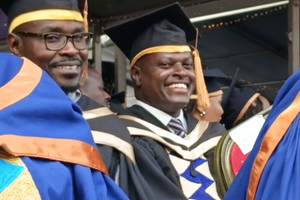Premium
Over 300,000 miss college slots

Kenya Universities and Colleges Central Placement Services chief executive John Muraguri (second left) with Kenya Accountants and Secretaries National Examinations Board officials during a meeting in Nairobi.PHOTO | FILE | NATION MEDIA GROUP
What you need to know:
- According to the Economic Survey 2020, enrolment of TVET institutions stood at 430,598 students in 2019. This does not compare favourably with that of universities, which was 509,473.
- KUCCPS boss John Muraguri decried the low participation of schools in guiding the candidates to make informed career choices.
More than half of the candidates who sat KCSE examinations last year stare at an uncertain future, as they will be locked out of post-secondary school training opportunities.
The more than 300,000 young people will join millions of others who have been jettisoned every year by an education system that places high premium on grades as a determinant of future careers and upward mobility.
The reality of the acute educational wastage came to the fore with the release of higher education placement data by the Kenya Universities and Colleges Central Placement Service (KUCCPS) on Tuesday last week.
TOP PERFORMERS
Although the limelight shone on the top performers who secured places in much-coveted courses at top universities and colleges, an analysis of the data and alternative training opportunities not captured by the KUCCPS shows that a huge number of youths might not access any kind of formal training.
This greatly diminishes their prospects of employment or self-employment, dealing a heavy blow to government efforts to expand post-secondary education and training.
With universities and technical and vocational education and training (TVET) institutions expected to absorb the 122,831 and 88,724 students allocated to them respectively, the bulk of last year’s 689,007 KCSE candidates will have to look elsewhere to further their education.
The expectation is that the 563,544 candidates who failed to secure university places will be accommodated in the TVET institutions. However, these can only accommodate less than half of that as their declared capacity is only 276,163 students.
It is also worth noting that TVET institutions admit candidates even from previous years, so the demand for places should be much higher. Strangely, many of them are under-enrolled, despite recent heavy government investment in the sector. However, the ambitious expansion and investment in TVET threatens to turn into a pipedream unless there is improvement on the uptake of the courses on offer.
EXPENSIVE EQUIPMENT
“For TVET, there are a number of students who still walk into institutions to get admission letters. Once the institutions make returns, we shall get the actual number enrolled. In addition, TVET admission, unlike that of universities, is continuous throughout the year. So we are likely to get the numbers,” Technical and Vocational Education and Training Authority (TVETA) director-general Dr Kipkirui Langat told the Sunday Nation.
Many TVET institutions have expensive equipment that continue to lie unutilised as they are plagued by biting staffing gaps that put off prospective trainees. Some of these have opted to enrol in unaccredited institutions, which the TVETA has been struggling to force to comply.
The State Department for Vocational and Technical Training has a proposed budget of Sh24.8 billion for the 2020/21 financial year, up from Sh17.1 billion. It is expected that part of the funds will be used to hire additional instructors.
According to the Economic Survey 2020, enrolment of TVET institutions stood at 430,598 students in 2019. This does not compare favourably with that of universities, which was 509,473.
Apart from the institutions allocated students by KUCCPS, there are others that admit Form Four leavers directly. These include the security forces and teacher training colleges. Last year, the National Youth Service admitted 12,194 recruits.
Private medical training institutes and the Kenya Medical Training Colleges also admit students independent of KUCCPS, but this still leaves a big number of youths without opportunities for formal training.
POOR GRADES
Whereas some candidates may not be admitted to their dream courses in universities, those who post poor grades in the KCSE examinations are the worst hit by limited training opportunities.
In the 2019 KCSE, 319,370 candidates scored a mean grade of D and below, which qualifies them for artisan certificate training. It should worry the Ministry of Education and other stakeholders that of that number, sub-county schools contributed 213,776 candidates (67 per cent).
Enrolment in sub-county schools has risen exponentially in the past 15 years across the country. They have afforded learners who would have otherwise missed out on secondary education an opportunity to better their lives. The majority of them operate as day schools.
To actualise the 100 per cent transition from primary schools, the MoE has relied mostly on the sub-county schools to accommodate the students. However, this has not been matched with requisite staffing and funding to improve infrastructure such as laboratories, libraries, ICT equipment.
This puts them at a disadvantage when they have to compete against their counterparts in schools with better infrastructure. It is the fate of the millions of students in sub-county schools that the government needs to prioritise to stem the educational wastage currently going on unabated.
CAREER CHOICES
KUCCPS boss John Muraguri decried the low participation of schools in guiding the candidates to make informed career choices.
“The board recommends to the Ministry of Education that it considers issuing a policy guideline to all schools, especially those with candidates eligible for placement to TVET institutions, to ensure that they submit the applications on behalf of their KCSE candidates for university and TVET placement,” Mr Muraguri said.
The KUCCPS data also revealed an increasing number of qualified candidates who shun university education for diploma courses in colleges.
This year, 2,632 candidates who scored C+ were enrolled in diploma courses, which was more than double the number last year.
“The growing number of these ‘TVET Champions’ is a clear indication that concerted efforts to improve enrolment in TVET courses are yielding fruits,” Prof Magoha said.





